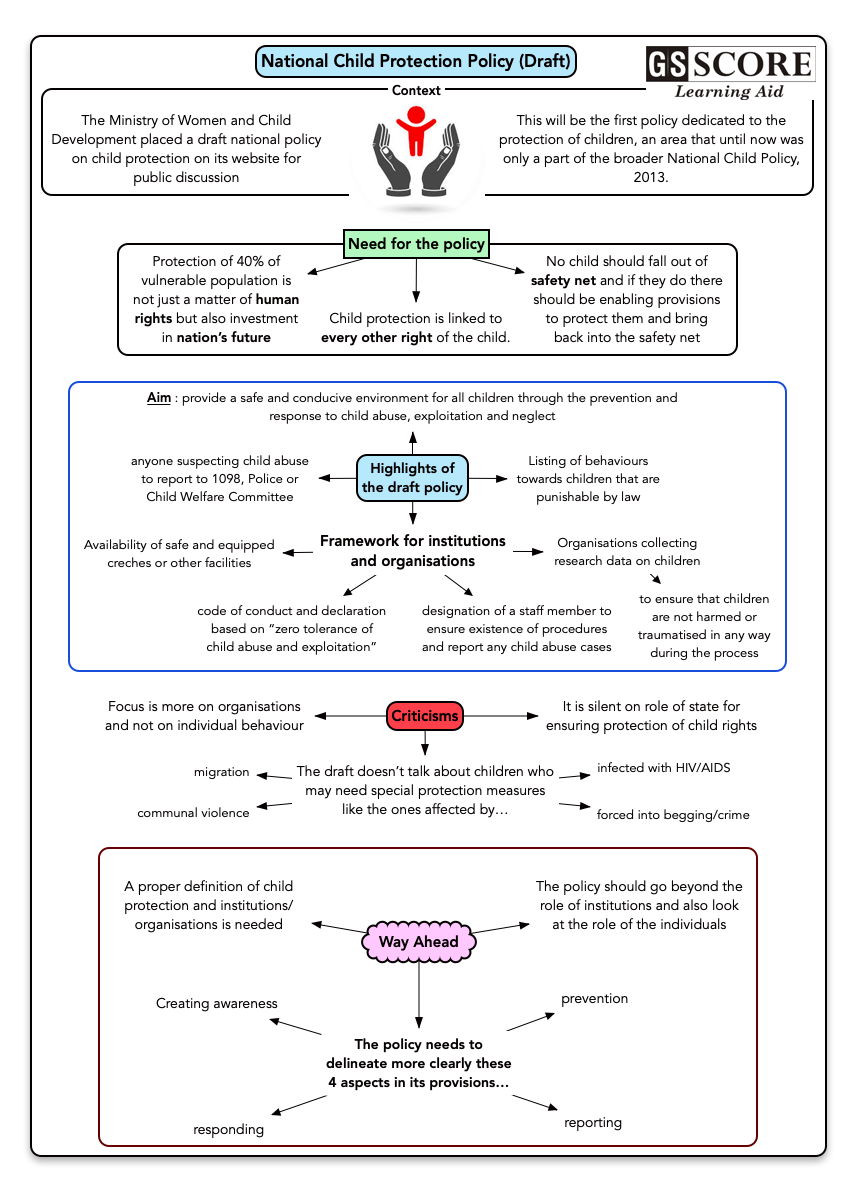

The Ministry of Women and Child Development has recently placed the draft National Policy on Child Protection. The protection of children until now is a part of the broader National Child Policy, 2013.
Issue
Context
- The Ministry of Women and Child Development has recently placed the draft National Policy on Child Protection. The protection of children until now is a part of the broader National Child Policy, 2013.
Background
- The Supreme Court had directed the CBI to investigate allegations involving 17 shelter homes for children, destitute women, beggars and senior citizens in Bihar following the case of sexual abuse of more than 30 girls in a shelter home in Muzaffarpur in the State. The apex court had also asked the Centre to consider framing a national policy on protection of children.
- A code of conduct for employees of all organisations and a declaration signed by them agreeing to ensure the safety of children are some of the provisions included in the Centre’s draft national child protection policy.
About
Why Child Protection Policy?
- All children deserve a happy childhood and the opportunity to lead a dignified life safe from violence, exploitation, neglect, deprivation and discrimination.
- India is a young nation, with a child population of more than 472 million. Protection of this 40% of the young population is not only a matter of their human rights but also an investment towards building a robust nation.
- The Constitution of India recognizes children as equal right holder and grants highest priority for their protection and well-being.
- India is also signatory to the United Nations Convention on the Rights of the Child (UNCRC) and accordingly has a strong legal framework to protect children which include the Juvenile Justice (Care and Protection of Children) Act 2015; the Protection of Children from Sexual Offences Act 2012; Pre-Conception and Pre-Natal Diagnostic Techniques (PCPNDT) Act 1994; the Commission for Protection of Child Rights Act 2005; the Right of Children to Free and Compulsory Education Act, 2009; Prohibition of Child Marriage Act, 2006; and Child Labour (Prohibition and Regulation) Amendment Act, 2016.
- A child protection policy also demonstrates the commitment of organizations and professionals to children and ensures public confidence in its safe practices.
Analysis
Highlights of the policy
- A policy has four aspects — creating awareness, prevention, reporting and respondin.
- The current policy draws upon the safeguards provided under the Constitutions of India, various child-centric legislation, international treaties as well as other existing policies for the protection and wellbeing of children.
- It aims at providing a safe and conducive environment for all children through the prevention and response to child abuse, exploitation and neglect.
- As per the draft, the policy provides a framework for all institution, and organization (including corporate and media houses), government or private sector to understand their responsibilities in relation to safeguarding/ protecting children and promoting the welfare of children; individually and collectively.
- The draft policy recommends that all organisations must have a code of conduct based on “zero tolerance of child abuse and exploitation” for employees of all organisations and a declaration signed by them agreeing to ensure the safety of children.
- The policy requires organisations to lay down that employees don’t use language or behaviour that is “inappropriate, harassing, abusive, sexually provocative, demeaning or culturally inappropriate”.
- Institutions should also designate a staff member to ensure that procedures are in place to ensure the protection of children as well as to report any abuse.
- Organizations that undertake research and collect data on children, directly from children or indirectly from parents/community must ensure that children are not harmed or traumatized in any way during the process. All research staff must be trained on ethical practices and child friendly procedures.
- Crèches/ mobile crèches for employee’s children including those on daily wages/contractual basis if the number of employees is fifty or above; otherwise appropriate space and facility for baby care to be provided for mothers with infants.
- Child friendly zones must be developed in all places for public dealing.
- Safe spaces for mothers to keep their infants.
- The document also comprises a list of behaviours towards children that are punishable by law, including the POCSO and JJ Acts.
Criticism
- Unlike the National Child Policy, 2013, the draft document doesn’t talk about children who may need additional special protection measures: including those affected by migration, communal or sectarian violence, children forced into begging or in conflict with the law, and those infected with HIV/AIDS.
- Policy is silent on the role of the state for ensuring the protection of child rights or addressing local grievances.
- Furthermore, while it talks about organisations laying down a code of conduct, it doesn’t explain acceptable behaviour such as conduct of teachers in schools.
Way Forward
- The document needs to define what child protection is as well as what it means by institutions or organisations.
- The norms should be designed in such a way that organisations can customize their policies according to the nature of their work, thereby, giving them a sense of ownership on safeguarding children’s rights.
- The government should use the opportunity which goes beyond the role of institutions and look at the role of individuals.
- The government could also look at ensuring that all officials in public service give an undertaking that they will not exploit children.
- The Policy should address four aspects- creating awareness, prevention, reporting and responding. The draft needs to go into all these aspects, especially reporting structure involving various nodal bodies and monitoring mechanism for implementation of the guidelines.
Learning Aid
Practice Question:
Enumerate the important provisions of the recently released draft national child protection policy.



